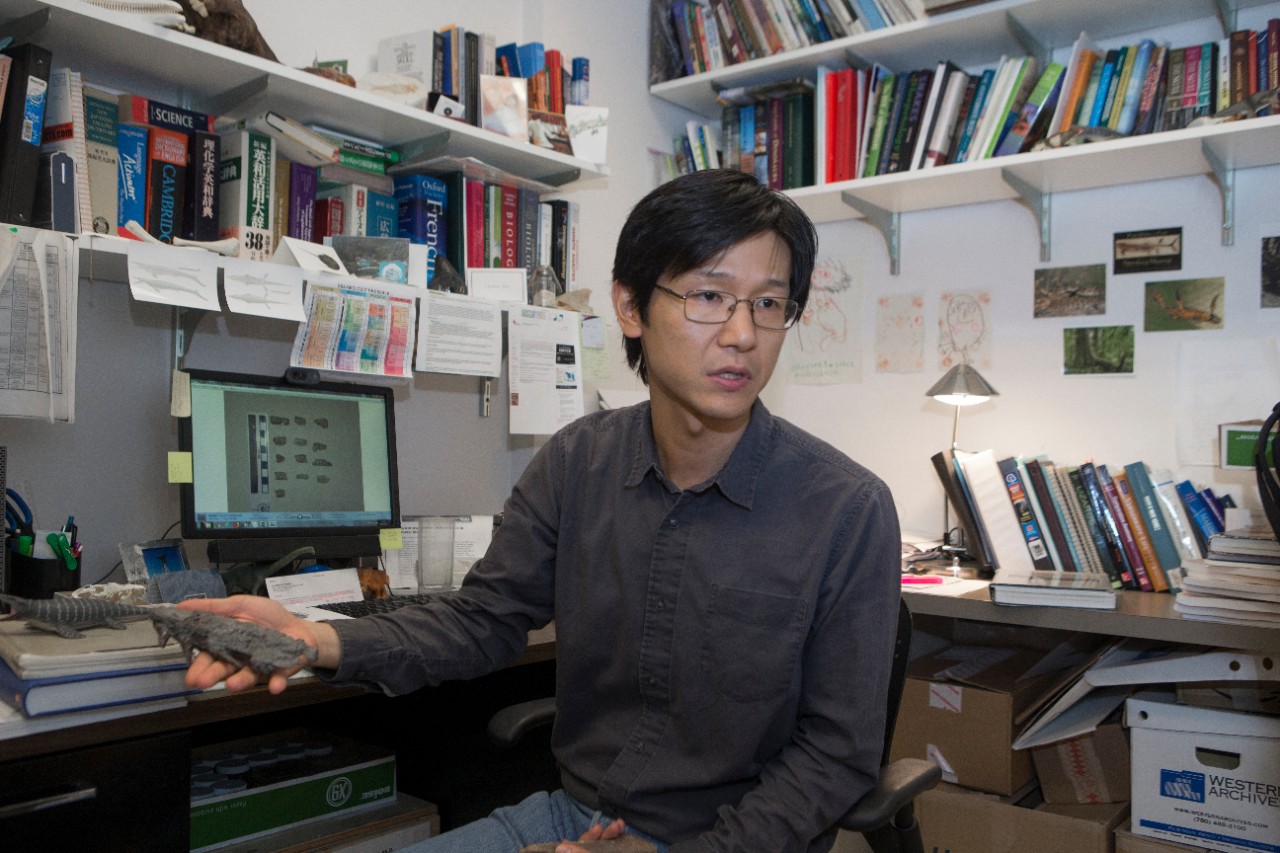
This Japanese ‘dragon’ terrorized ancient seas
A mosasaur called the Wakayama ‘blue dragon’ ruled prehistoric waters
Researchers have described a Japanese mosasaur the size of a great white shark that terrorized Pacific seas 72 million years ago.
Extra-long rear flippers might have aided propulsion in concert with its long finned tail. And unlike other mosasaurs, or large extinct marine reptiles, it had a dorsal fin like a shark’s that would have helped it turn quickly and with precision in the water.
University of Cincinnati Associate Professor Takuya Konishi and his international co-authors described the mosasaur and placed it in a taxonomic context in the Journal of Systematic Palaeontology.
The mosasaur was named for the place where it was found, Wakayama Prefecture. Researchers call it the Wakayama Soryu, which means blue dragon. Dragons are creatures of legend in Japanese folklore, Konishi said.
“In China, dragons make thunder and live in the sky. They became aquatic in Japanese mythology,” he said.
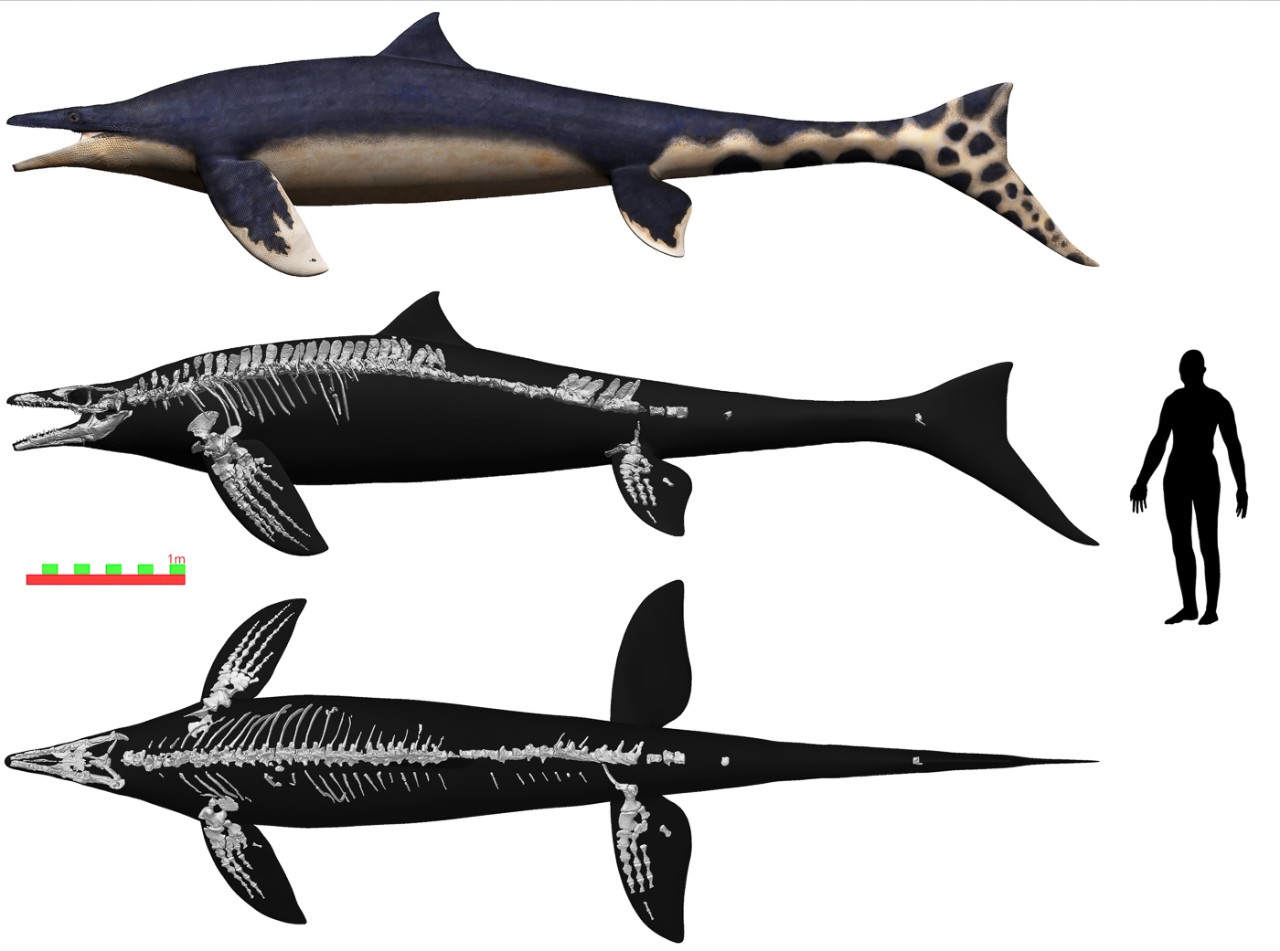
The Wakayama Soryu was about the size of a great white shark and lived more than 72 million years ago during the age of Tyrannosaurus rex and other late-Cretaceous dinosaurs. Illustration/Takumi
The specimen was discovered along the Aridagawa River in Wakayama by co-author Akihiro Misaki in 2006. Misaki was looking for fossils of invertebrates called ammonites when he found an intriguing dark fossil in the sandstone, Konishi said.
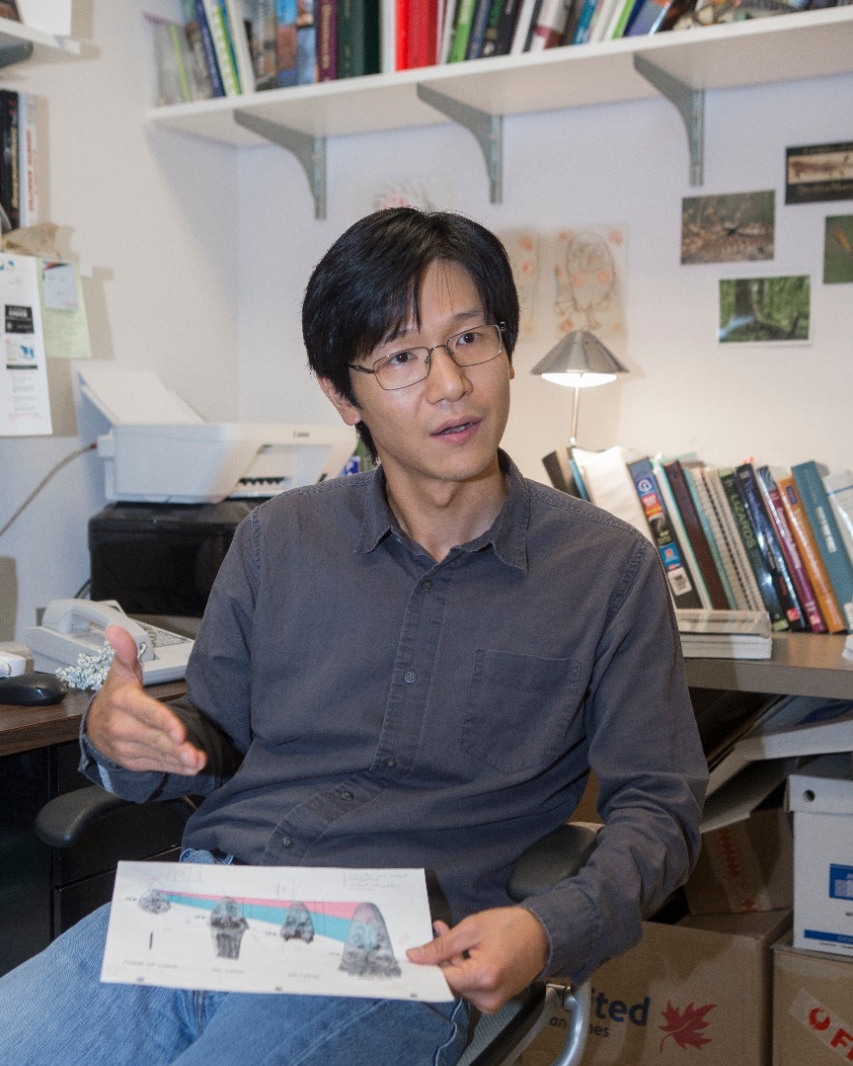
UC College of Arts and Sciences Associate Professor Takuya Konishi has studied mosasaurs for more than 15 years. Photo/Joseph Fuqua II/UC
Misaki continued looking for ammonites before curiosity got the better of him and he returned to the dark bone. Closer examination revealed it was a vertebra, part of a nearly complete mosasaur captured in the hard sandstone.
The specimen is the most complete skeleton of a mosasaur ever found in Japan or the northwestern Pacific, Konishi said.
“In this case, it was nearly the entire specimen, which was astounding,” Konishi said.
He has dedicated his career to studying these ancient marine reptiles. But the Japanese specimen has unique features that defies simple classification, he said. Its rear flippers are longer than its front ones. These enormous flippers are even longer than its crocodile-like head, which is unique among mosasaurs.
“I thought I knew them quite well by now,” Konishi said. “Immediately it was something I had never seen before.”
Mosasaurs were apex predators in prehistoric oceans from about 100 million years ago to 66 million years ago. They were contemporaries of Tyrannosaurus rex and other late Cretaceous dinosaurs that ruled the Earth. Mosasaurs were victims of the same mass extinction that killed off nearly all dinosaurs when an asteroid struck what is now the Gulf of Mexico.
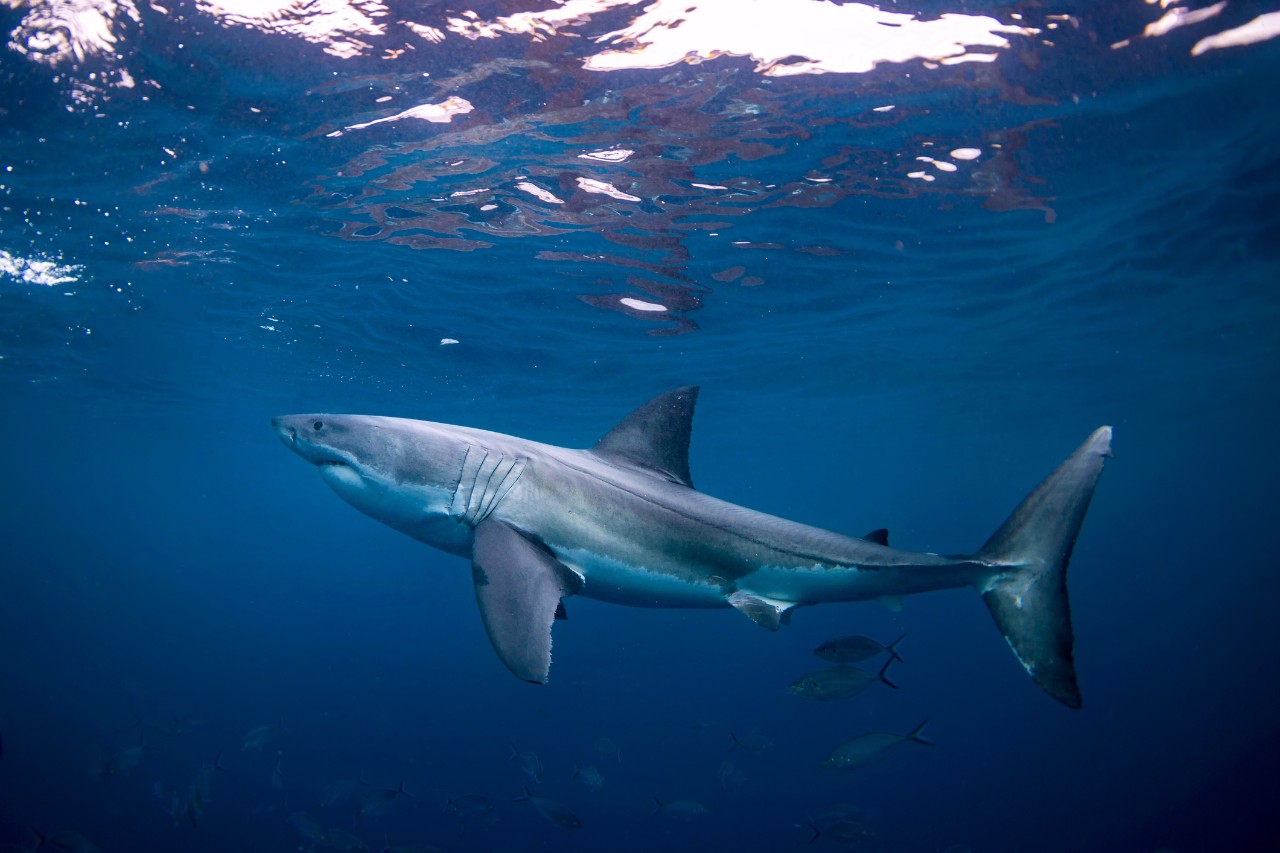
A mosasaur analyzed by University of Cincinnati paleontologist Takuya Konishi had a dorsal fin like that of a great white shark that allowed it to maneuver with precision in the water. Photo/Grisha Shoolepoff
The Wakayama Soryu has some features similar to mosasaurs found in New Zealand and other features comparable to mosasaurs found in California, he said.
It had nearly binocular vision that would have made it a lethal hunter, he said.
Researchers placed the specimen in the subfamily Mosasaurinae and named it Megapterygius wakayamaensis to recognize where it was found. Megapterygius means “large winged” in keeping with the mosasaur’s enormous flippers.
It opens a whole can of worms that challenges our understanding of how mosasaurs swim.
Takuya Konishi, UC Associate Professor of Biological Sciences
Konishi said those big paddle-shaped flippers might have been used for locomotion. But that type of swimming would be extraordinary not only among mosasaurs but among virtually all other animals.
Another prehistoric marine reptile called the plesiosaur used its paddle fins for propulsion, but it didn’t have a long rudderlike tail, he said.
“We lack any modern analog that has this kind of body morphology — from fish to penguins to sea turtles,” he said. “None has four large flippers they use in conjunction with a tail fin.”
Researchers speculated that the large front fins might have helped with rapid maneuvering while its large rear fins might have provided pitch to dive or surface. And presumably like other mosasaurs, its tail would have generated powerful and fast acceleration as it hunted fish.
“It’s a question just how all five of these hydrodynamic surfaces were used. Which were for steering? Which for propulsion?” he said. “It opens a whole can of worms that challenges our understanding of how mosasaurs swim.”
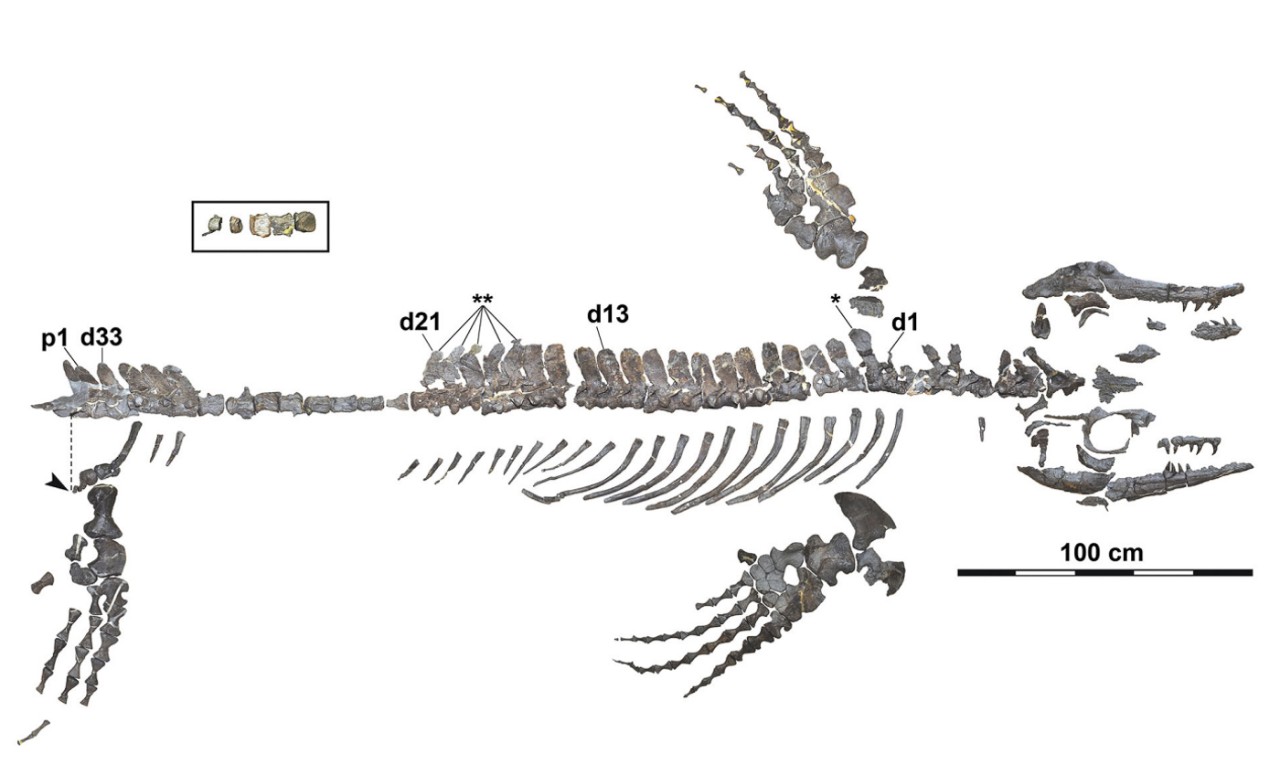
A mosasaur discovered in Japan was the most complete skeleton ever found in Japan or the northwestern Pacific. Graphic/Takuya Konishi
Unique to mosasaurs, the Wakayama Soryu apparently had a dorsal fin, based on the orientation of the neural spines along its vertebrae. The orientation of these spines is remarkably similar to that of a harbor porpoise, which also has a prominent dorsal fin, the study found.
“It’s still hypothetical and speculative to some extent, but that distinct change in neural spine orientation behind a presumed center of gravity is consistent with today’s toothed whales that have dorsal fins, like dolphins and porpoises,” he said.
A team of researchers spent five years removing the surrounding matrix of sandstone from the fossils. They also took a cast of the mosasaur in place to provide a record of the skeletal orientation of the bones before they were excavated.
The preparation of the fossil was supported by grants from Japan’s Ministry of Health, Labour and Welfare, and the National Sciences and Engineering Research Council of Canada, which helped researchers compare the newly described specimen with mosasaurs from around the world.
Featured image at top: An illustration of the mosasaur Megapterygius wakayamaensis. Illustration/Takumi
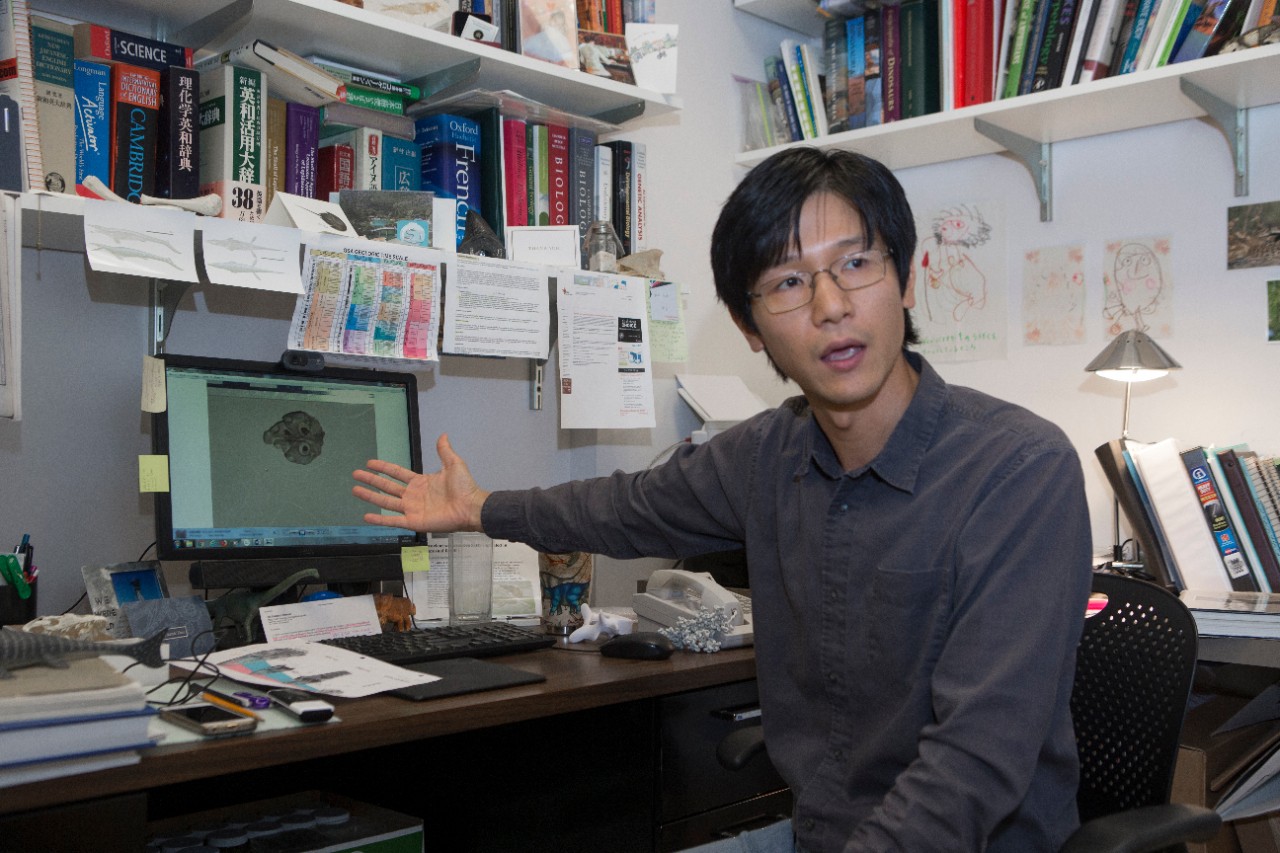
UC Associate Professor Takuya Konishi is an expert on ancient marine reptiles such as mosasaurs. Photo/Joseph Fuqua II/UC
Next Lives Here
The University of Cincinnati is leading public urban universities into a new era of innovation and impact. Our faculty, staff and students are saving lives, changing outcomes and bending the future in our city's direction. Next Lives Here.
Related Stories
UC study examines impact of incarceration on youth health
July 19, 2024
Samantha Boch, PhD, at the UC College onf Nursing, has studied the impact of incarceration on child and family health for more than a decade. Her latest research examines youth health in Cincinnati and relies on collaboration with Cincinnati Children's Hospital.
UC professor awarded for lifetime achievement in photocatalysis
July 19, 2024
Panagiotis (Peter) Smirniotis has been at the University of Cincinnati's College of Engineering and Applied Science since 1994. He is known for impactful, interdisciplinary research focusing on various environmental and energy problems. Recently, he was honored with the inaugural David F. Ollis Award for lifelong achievements from the International Scientific Society of Semiconductor Photocatalysis and Solar Energy Conversion. The award is named after the influential professor and pioneer in the field.
Designing the next generation of drug delivery
July 18, 2024
UC Assistant Professor Briana Simms talks to PhRMA about using nanoparticles to deliver medicine.
Mural by UC grad honors U.S. military history
July 17, 2024
Local 12 highlighted a new mural by University of Cincinnati graduate and artist Brandon Hawkins that pays tribute to U.S. military history.
Social media fuels extreme political rhetoric
July 17, 2024
UC College of Arts and Sciences Professor Jeffrey Blevins tells Local 12 that online algorithms fuel political polarization on social media.
We love ‘Lucy’ — the AI avatar redefining UC tech transfer
July 17, 2024
In a visionary leap at the University of Cincinnati, the marriage of artificial intelligence and interactive technology has birthed "Lucy," a Smarthelp AI avatar poised to revolutionize how regional industries engage with UC's tech transfer initiatives.
NIS program opens new horizons for international student
July 17, 2024
In his pursuit of physics and a taste for research, Akash Khanikor ventured from his hometown in India's Assam to the University of Cincinnati, drawn by the promise of hands-on exploration early in his undergraduate career as a NEXT Innovation Scholar.
Camp aims to empower children, teens who stutter
July 17, 2024
A one-week, evidence-based program for children and teens who stutter at the University of Cincinnati will teach kids to communicate effectively, advocate for themselves and develop confidence about their communication abilities. Camp Dream. Speak. Live., which is coming to Cincinnati for the first time July 22-26, began in 2014 at the University of Texas at Austin. The Arthur M. Blank Center for Stuttering Education and Research at UT expects to serve more than 2,000 children at camps across the United States, Africa, Asia and Europe this year.
UC Blue Ash takes next step in major renovation project
July 17, 2024
Muntz Hall, the flagship building on the University of Cincinnati Blue Ash College campus, is in the next phase of a major renovation project that will dramatically transform the main entrance, enhance access to student support services and add new spaces for students to study or meet between classes.
UC archivist explores Troy’s invisible workers
July 17, 2024
UC Classics archivist Jeff Kramer examined the unheralded and largely uncredited role laborers played in the 1930s excavation at Troy in Turkey.
